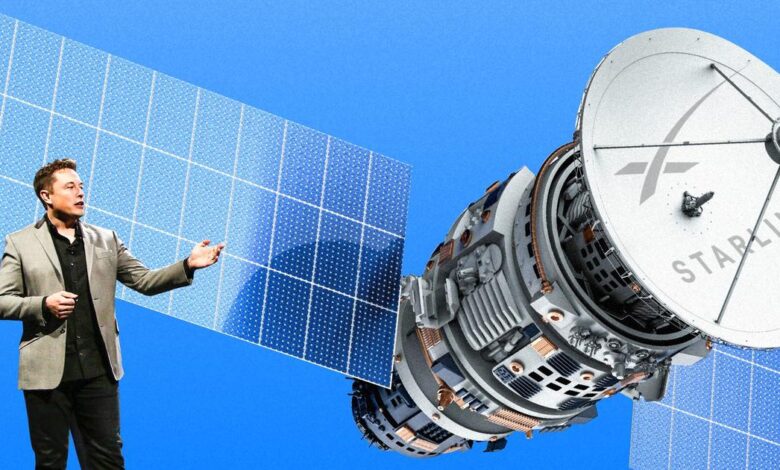
Starlink Business is a satellite internet service operated by SpaceX that aims to provide high-speed, low-latency broadband internet across the globe. The service is enabled by a constellation of satellites in low Earth orbit that beam internet connectivity directly to small user terminals on the ground.
Some of the key features and benefits of Starlink include:
-
High-speed connectivity – Starlink is capable of download speeds between 100-200 Mbps and latency as low as 20ms, rivaling cable and fiber optic internet. This enables video calling, online gaming, streaming, and other bandwidth-intensive uses.
-
Global coverage – With over 2,000 satellites launched already, Starlink’s constellation provides internet access to customers in rural and remote areas where fiber or cable internet is not available. Service can be accessed across continents and oceans.
-
Rapid deployment – A small Starlink kit can be set up in just minutes at a location. No need to wait for cable lines or infrastructure. Users can quickly get online.
-
Mobility – Starlink works with mobile devices, enabling internet access on the move. RV travelers, boats, and remote work can benefit from connectivity.
-
Reliability – The satellite network provides consistent, uninterrupted access unlike spotty ground-based systems. Service works even in inclement weather.
-
Affordability – Starlink aims to offer satellite internet service at an affordable consumer price point compared to traditional options.
With its unique space-based delivery system, Starlink promises to make high-speed internet accessible to more people globally, opening up new opportunities for connectivity.
Target Customers
Starlink Business is designed for enterprise and business customers that require high-speed, low-latency internet in locations not served by traditional broadband. The unique value of Starlink comes from its ability to provide broadband internet access globally through its network of low earth orbit satellites.
Ideal customers for Starlink Business include:
-
Remote businesses and offices: Companies with locations in rural or remote areas without access to cable or fiber broadband can benefit from Starlink. This allows them to stay connected no matter how remote the office.
-
Maritime businesses: Cruise ships, cargo vessels, and commercial fishing boats can take advantage of Starlink internet while at sea. This enables operations, guest connectivity, and crew morale when away from shore.
-
Temporary worksites: Construction sites, mining operations, disaster relief services, and other temporary locations often lack permanent broadband infrastructure. Starlink provides immediate connectivity.
-
Mobile businesses: Mobile businesses like tour operators, RV rental companies, news crews, and first responder vehicles can maintain internet access anywhere they drive or travel.
-
Distributed enterprises: Large enterprises with distributed sites, stores, or assets that are impractical to connect via fiber or cable can leverage Starlink’s satellite network for connectivity. Examples include retail chains, restaurant franchises, manufacturing plants, and more.
The common thread is that Starlink Business provides broadband speeds comparable to cable and fiber internet, but without geographic restrictions. For enterprises operating in remote areas or requiring internet across distributed sites, Starlink delivers unique value.
Internet Performance
Starlink utilizes a network of satellites in low Earth orbit to provide high-speed, low-latency internet across the globe. This makes Starlink well-suited for business use cases that require reliable and consistent connectivity.
Download/Upload Speeds
Starlink advertises download speeds between 100 Mbps and 200 Mbps and upload speeds between 10 Mbps to 20 Mbps. While not as fast as fiber, these speeds are significantly faster than typical satellite internet services which offer 25Mbps down and 3Mbps up. Starlink’s performance is comparable to cable internet speeds.
Latency
Latency refers to the time it takes for data to make a round trip. Satellite internet is notorious for high latency due to the distance signals must travel to satellites in geosynchronous orbit. Starlink’s satellites are in low Earth orbit just 340 miles above the surface. This allows Starlink to achieve latencies between 20ms to 40ms which is suitable for voice calls, video conferencing, and gaming.
Reliability
Starlink’s satellite network provides consistent uptime as there is redundancy built into the system. If one satellite goes down, neighboring satellites provide coverage. Users can expect continuous access unless there are extreme weather events blocking the line of sight between the dish and satellites.
Consistency
Starlink aims to deliver consistent speeds around the clock, unlike some broadband networks that experience slowdowns during peak usage hours. However, users may see some variation based on local weather conditions, position of satellites, and other factors. But Starlink’s advanced networking algorithms and ability to route traffic dynamically helps maximize consistency.
Pricing and Equipment
Starlink Business requires an upfront investment in equipment and installation along with a monthly fee for service.
Monthly Service Fees
Starlink Business service starts at $500 per month. This provides download speeds of 100-200 Mbps. Higher speed tiers are available for additional monthly fees.
Upfront Hardware and Installation Costs
To use Starlink Business, you’ll need to purchase the following hardware:
- Starlink satellite dish – $2,500
- Starlink router – $650
- Cables and mounts – $350
Professional installation is recommended, which costs approximately $1,000.
In total, expect around $4,500 in upfront costs for hardware, accessories and installation.
Required Equipment
The main equipment needed includes:
-
Starlink satellite dish – This specialized dish connects to the Starlink satellites in orbit. It has motors to self-adjust alignment as satellites move across the sky.
-
Starlink router – A WiFi router is needed to broadcast the internet connection in your office or facility. The Starlink router is optimized to work with their system.
-
Cables and mounts – Coaxial cables connect the dish to the router. A roof/pole mount is required to securely attach the satellite dish.
Getting set up with Starlink Business requires a significant upfront investment, but provides high-speed low-latency internet even in remote areas unserved by fiber. Ongoing costs are reasonable compared to legacy satellite internet services.
Limitations
Starlink’s satellite internet service comes with some limitations that businesses should be aware of before signing up.
-
Data caps – Starlink implements data caps on its plans, ranging from 250GB/month on the basic plan up to 500GB/month on the premium plan. Businesses with high data needs may find these caps restrictive. Exceeding the cap results in slowed speeds.
-
Coverage areas – The Starlink constellation is still being built out, so coverage is limited mainly to areas between 44 and 53 degrees latitude currently. Availability at a specific location can be checked on their website. Expanding coverage to more areas is a work in progress.
-
Weather disruptions – Since the signal travels from satellites in space, it can be interrupted by severe weather events like heavy rain, snow or wind storms. Most disruptions are temporary, but businesses in extreme weather regions may experience more outages.
-
Capacity constraints – As the service expands, capacity could become an issue in densely populated areas. Starlink has plans to launch more satellites to increase capacity. But bandwidth-intensive businesses could still run into congestion issues affecting speeds.
Competitors
Starlink faces competition from several sources in the business internet market.
Other Satellite Internet Providers
Starlink’s most direct competitors are other satellite internet providers such as HughesNet and Viasat. These providers operate geostationary satellites in much higher orbits compared to Starlink’s low earth orbit satellites. The higher latency of geostationary satellites makes HughesNet and Viasat better suited for more basic internet usage rather than advanced applications. However, they do have more mature satellite fleets currently in operation.
Rural Wired Broadband
For businesses located in rural areas that happen to have access to wired broadband from cable or fiber networks, these likely provide lower latency and more reliable speeds than any satellite internet service. However, wired broadband infrastructure is not available in many remote regions.
5G Fixed Wireless
An emerging competitor is 5G fixed wireless internet, which transmits a 5G cellular signal to a business location through an external antenna and router. This can provide speeds competitive with Starlink while avoiding satellite latency. However, 5G fixed wireless is still building out coverage and has limited availability today.
Case Studies
Starlink has enabled several businesses to thrive in remote areas or operate more efficiently. Here are some examples:
Remote Eco-Lodge
An eco-lodge located deep in a national forest struggled with slow and unreliable satellite internet. Guests complained about not being able to access entertainment, get work done, or make video calls. After switching to Starlink, the owners saw guest satisfaction scores improve. Fast, reliable internet enabled activities like streaming nature documentaries, taking online classes, and making video sales calls.
Farm Equipment Company
A company selling farm equipment found it difficult to showcase tractors and implements to potential buyers, since their rural location lacked fast internet. Sales reps could not give virtual demonstrations of equipment or quickly send spec sheets and quotes. Starlink allowed reps to hold video calls with farmers across the country, give immersive demos, and send files instantly. Leads and sales rose significantly.
Mobile Medical Clinic
A nonprofit medical clinic struggled to serve patients in rural towns, because they could not access patient records, prescribe medication, or analyze test results without fast, reliable connections. With Starlink, doctors can now access the clinic’s database, e-prescribe, review X-rays, and consult colleagues from anywhere. Patient care improved dramatically.
Disaster Relief Organization
After hurricanes, floods or fires, a disaster relief organization found it difficult to coordinate supplies and volunteers in areas with damaged internet infrastructure. With Starlink portable terminals, they can now set up instant connectivity to manage logistics, process donations, and communicate updates after arriving on site. Operations are more efficient and responsive.
Future Roadmap
Starlink has ambitious plans to continue expanding and enhancing its satellite internet service. Here are some of the key items on Starlink’s roadmap:
-
Expanded coverage: Starlink aims to achieve near global coverage by the end of 2023, with a particular focus on reaching remote and rural areas. They plan to launch additional satellites into orbit regularly to make this happen.
-
Enhanced performance: As more satellites are launched, performance is expected to improve in terms of speeds, latency, and reliability. Starlink is targeting latency under 20ms and download speeds over 200 Mbps.
-
Increased capacity: With thousands more satellites planned for launch, Starlink intends to have the capacity to support millions of users simultaneously. This will help ensure quality of service as demand grows.
-
Next generation satellites: Starlink is already developing a version 2.0 satellite with larger antennas and other upgrades to unlock greater performance. These are expected to start launching in 2023.
-
New ground technology: Starlink is working on cutting-edge phased array antennas and modems to allow faster internet speeds through their satellite network.
-
Business services: Starlink aims to offer specialized services for business and enterprise customers beyond standard residential offerings.
Overall, Starlink’s roadmap centers around scaling up rapidly to achieve global broadband coverage and support a massive future customer base with fast, reliable satellite internet. As technology improves, Starlink intends to remain on the cutting edge.
Getting Started
Ordering and setting up Starlink Business is straightforward:
-
Visit the Starlink website and select Starlink for Business. Choose your business address and fill out the signup form.
-
You’ll receive a confirmation email and be contacted by a Starlink sales representative to finalize your order. Select your equipment options like the mount type and cable lengths.
-
The startup kit which includes the satellite dish, wifi router, cables and mounts is then shipped to your business location. Expect about 1-2 weeks for delivery after order confirmation.
-
A certified Starlink installer will schedule an appointment to set up your equipment. Installation takes 2-4 hours depending on the location specifics. The installer will position the satellite dish for an unobstructed view of the sky and connect all the system components.
-
Once installed, the Starlink wifi network will be live and ready to connect devices. You can manage network settings through the Starlink app. Expect internet speeds of 100-200 Mbps low latency broadband to power your business needs.
-
Ongoing maintenance is minimal. The satellite dish is weather-sealed and the system is designed for reliable hands-off operation. Starlink will push any software updates to your system automatically.
Getting setup with Starlink Business takes less than a month from order to installation. The user-friendly system provides dedicated high-speed internet to empower businesses anywhere. Contact Starlink today to experience the future of connectivity.
Conclusion
Starlink Business provides high-speed, low-latency satellite internet that can be a game changer for businesses in rural and remote areas. Key benefits of Starlink Business include:
-
High-speed internet with download speeds of 100-200 Mbps and low latency below 30ms. This enables businesses to do data-intensive tasks like video conferencing that were not possible before on slow DSL or cellular connections.
-
Reliable connectivity with continuous uptime. The satellites provide consistent coverage, unlike ground-based internet that can have interruptions due to weather, terrain, etc.
-
Quick and easy setup. The self-install kit allows businesses to get online within minutes. No need to wait weeks for a technician appointment.
-
Portable connectivity. The antenna and wifi router can be taken anywhere within the coverage area, enabling mobile offices and pop-up locations.
-
Cost effective pricing with no long-term contracts. Plans start at $500/month for speeds up to 100 Mbps.
Businesses in rural, remote, and traditionally underserved locations should consider Starlink Business if they need fast, reliable internet to grow their operations. The service is ideal for farms, manufacturing facilities, multi-location retailers, outdoor recreational businesses, emergency responders, and more. With Starlink, businesses no longer have to settle for poor broadband access just because of their location.





